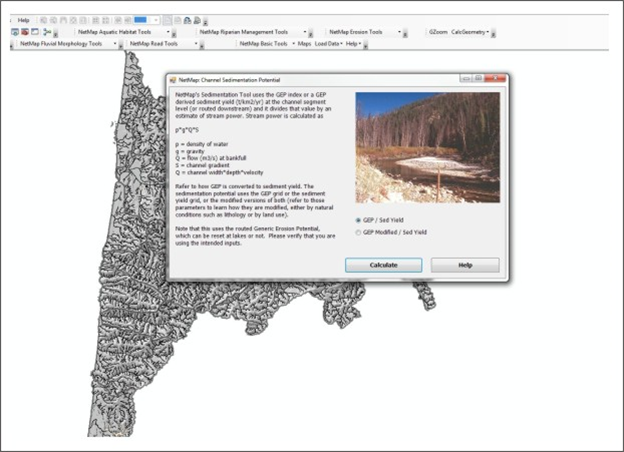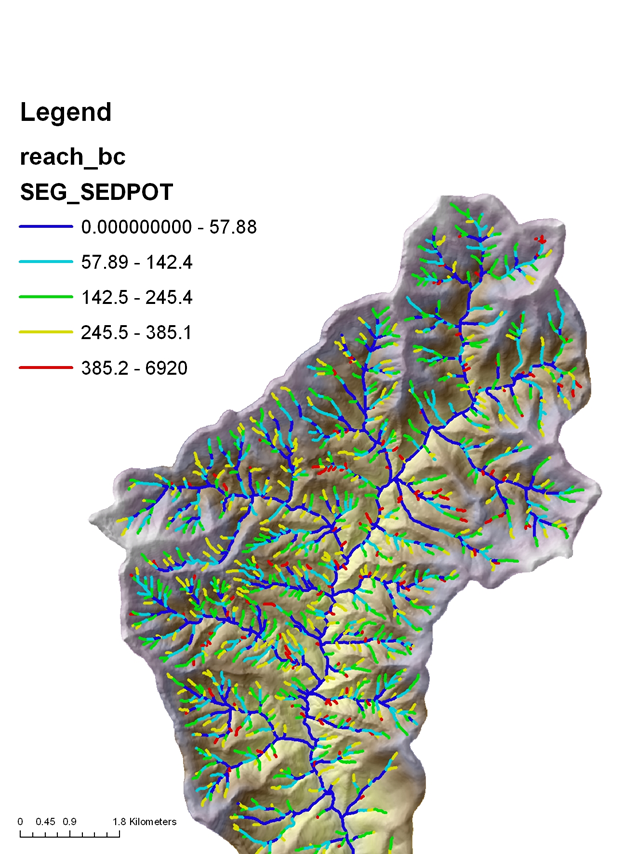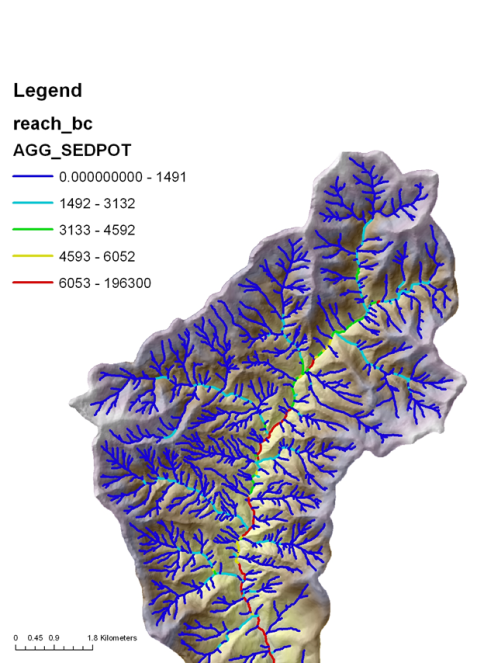| < Previous page | Next page > |
Channel Sedimentation PotentialChannel Sedimentation Potential
Parameter Description: NetMap’s Channel Sedimentation Model uses either Generic Erosion Potential (GEP) or it conversion form of sediment field (t/km2/yr). Sedimentation potential is based on GEP or sediment yield divided by Stream Power. Stream power is calculated as channel slope gradient multiplied by drainage area.
Data Type: Line (stream layer)
Field Name: LOCSEDPOT; Common Name: Local Sedimentation Potential (uses GEP or sediment yield)
Field Name: CUMSEDPOT; Common Name: Cumulative Sedimentation Potential (uses GEP or sediment yield)
Field Name: LOCSEDPOTM; Common Name: Local Sedimentation Potential (using modified GEP or sediment yield)
Field Name: CUMSEDPOTM; Common Name: Cumulative Sedimentation Potential (using modified GEP or sediment yield)
Units: GEP/Stream Power or Sediment Yield (t/km2/yr)/Stream Power
NetMap Module/Tool: Erosion
Model Description:
Sedimentation potential is estimated by dividing the sediment supply index (either GEP or sediment yield [t km-2 yr-1]) by stream power (Figure 1). Stream power is a measure of the energy of a stream channel including that which is related to the ability to transport sediment, including bedload and suspended load. Stream power is calculated as: ρgQs where ρ is density of water (1000 kg/m3), g is acceleration due to gravity (9.8 m/s2), Q is discharge (m3/s) and S is channel slope. Q is calculated as WdV where W is bankfull channel width (m), d is bankfull channel depth, and v is velocity (m/s).
 Figure 1. NetMap's sedimentation tool.
In addition to channel-segment based predictions of sediment supply and sedimentation, NetMap includes two parameters designed solely to address confluence related environments. NetMap includes other parameters that characterize the potential for confluences to create unique geomorphic environments (see Parameter Library) but they do not address the issue of sediment supply (i.e., the relative importance of tributary fluxes of sediment compared to the sediment flux of the mainstem) or channel conditions at the confluence that would promote or discourage confluence effects (i.e., channel gradient or stream power). Thus, NetMap includes two other parameters that can be used to consider the potential for watersheds to create unique confluence environments. The first is the ratio of predicted sediment supply between the mainstem and the tributary (e.g., aggregated GEP of the tributary/aggregated GEP of the mainstem); the lower the ratio, the more likely the tributary can create unique confluence environments in mainstem rivers (e.g., Ferguson et al. 2006). The second parameter takes the confluence ratio of sediment supply and divides it by stream power (of the mainstem channel segment where the tributary intersects). Thus, higher values of this parameter should be associated with confluences that may have a higher likelihood of creating certain types of depositional environments. These two confluence-related sediment parameters should be used in conjunction with other confluence and stream parameters in NetMap to estimate the likelihood of encountering confluence effects in watersheds.
The erosion and sedimentation indices are calculated at two different scales (Figures 2 and 3), including 1) local sediment supply to channel segments, in GEP/ yr (GEP/km2/yr) and 2) channel GEP aggregated downstream, called cumulative sediment supply and area weighted, in GEP/km2/yr1, 4). Sediment yields in terms of tons are expressed in the same formats (e.g., t/km2/yr).
Table. The erosion and sedimentation parameters (GEP and sediment yield) in NetMap are located in the Erosion map generator.
 Figure 2. Sedimentation potential at the reach (100 m) scale using local (stream adjacent hillside, drainage wing) erosion and sediment supply potential.
 Figure 3. Sedimentation potential at the reach (100 m) scale using aggregated or cumulative erosion and sediment supply potential.
|